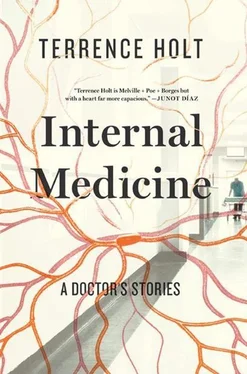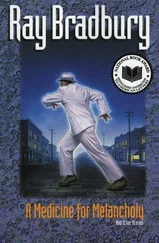“Make it stat,” I added as an afterthought. “And tell her nurse.”
Despite what you may see doctors do on TV, I hardly ever order anything stat. You can get a bad reputation. Everyone knows that what you really mean is, I forgot to order this and I want to go home for dinner . Today it meant something else. Vague fears. Impending doom. Abd pain &  wbc/lactate .
wbc/lactate .
AROUND FOUR THAT AFTERNOON, Mike, my intern, paged me with the news that we had two new admissions waiting in the ER: a young man with sickle-cell disease and joint pain and a chemotherapy patient who had been vomiting uncontrollably for several days. I told him to start on the sickler; sickle-cell pain crises are usually routine, and beyond the need to make sure the patient’s marrow and lungs are still working, management is a matter of ordering IV fluids, narcotics, and the laxative of choice. I went to the nearest workstation to look up the records of the other patient, a young woman with metastatic breast cancer and a recent history of frequent admissions for nausea and vomiting. She had three young children and seemed to do better when someone took care of her for a change. We’d treat her and send her home, she’d take care of her children until she needed to come in again, and it was going to go on like that until one day she wouldn’t go home. Armoring myself dully against the implications of this, I lumbered down to the ER to talk to her, trying not to think about anything but the treatment of nausea.
I SHOVED THE CLIPBOARD for Bay 11 back into its slot and fished a blank order sheet off the top shelf. The shelf is a bit of a reach for me, and as I stood there, stretched high on tiptoe, I found myself staring at a pair of surgery residents a few feet away. I knew the senior, Sara Barnes, a fifth-year unusual among her kind for a helpful civility with the other house staff. She was in earnest conversation with her intern, a sour-faced young woman who looked ready to quit. They were holding a large dark square of radiography print up to the overhead fluorescents. I recognized the patchwork of a CT scan. Sara gestured to a series of images on the lower third of the print.
“There,” she was saying. “See it? Where the contrast makes that little V and stops?”
“Yeah,” said the intern.
Sara ignored her tone. “It’s classic. They call it arrowhead sign: it’s practically pathognomonic for appendicitis.”
“Okay,” said the intern.
Appendicitis is, by definition, a surgical emergency. I’d actually seen it only twice in my life, during rotations in medical school. As my hand groped along a seemingly empty shelf, I found myself automatically rehearsing what I knew about appendicitis. That little worm at the base of the colon gets blocked off for any number of reasons; infection, inflammation, and swelling set in, along with nausea, and pain so variable in its location as to be notoriously misleading; pretty soon the organ gets so distended it cuts off its own blood supply. Tissue dies.
And as it dies, it produces lactate.
“We’ve got to find whoever ordered this,” Sara said, and her eyes started questing around the room.
My hand by this time had found the order sheet it was looking for, but I was no longer concerned with what my hand had found.
“Is that Crawley?” I called. “Is that Ariel Crawley’s CT? I ordered that.”
It took Sara a moment to focus on me. Then the two of them were around me, barking.
I let them go on, cherishing the growing warmth of my realization that they were talking about taking A. Crawley to the OR tonight. Even though this would ultimately benefit Virgie, not me, I couldn’t help but feel a flush of misplaced pride. Virgie would emerge from her call night with one fewer patient to round on in the morning. Good for Virgie. I was taking care of my orphan.
Sara and her intern left, busy, satisfied. I placed a page to Virgie to let her know. And then I sat down to order ondansetron and Ativan for the patient I’d just admitted in 11, whom I could still see, through a gap in the curtains, retching in a basin, a mauve turban askew on her hairless skull.
AROUND EIGHT P.M. I was up on 3 Central, passing through on my way from the ED, where our last two admissions of the day were still having the finishing touches added to their admission orders. I was on my way up to the cancer ward, where the patient in the turban was still vomiting. There was little purpose in my putting in an appearance, having ordered more Ativan for her over the phone, but I felt the obligation. And the ER was making me weary. While admitting our full five patients, I had also helped Virgie with three more. She still had two scheduled transfers, both end-stage livers for transplant evaluation, coming in by plane from elsewhere, and both delayed by weather. I had no idea what weather might be happening outside to delay the air ambulance, but I was glad of it. My own intern had capped. We had survived. All that remained for me to do was to help Mike get his patients settled. Then I could scuttle off to my call room and try to sleep.
I ducked into the 3 Central nursing station and called up Virgie’s census. A. Crawley should be on her way off it, heading to surgery. But you can’t take things like that for granted in the hospital, which is why transfers are dangerous; sometimes people fall into the cracks. I needed to check.
She was still on Virgie’s census, lodged inevitably in one of the rooms far down the hallway, at the end of a cul-de-sac. The back corner of 3 Central was not a good place to be. There was an old story in circulation about a patient on that hallway dialing 911: the nurse had ignored her call bell that long. The story was almost certainly apocryphal, but like most hospital legends it reflected a truth. The biggest threat to Ariel Crawley, stuck back in that corner with her gangrenous appendix, was that between scheduled vital signs no one would simply happen to walk by. I wondered when Virgie had last looked in on her, and as I clicked through the workstation to get at labs, I paged Virgie.
Crawley’s seven p.m. labs were coming up on the screen just as the telephone rang.
“Virgie,” I said. She said something very fast and incoherent in return.
Or maybe it was me. Certainly my own thoughts went suddenly too fast to follow as numbers outlined in red seemed to fill up the screen.
“I just got a page from Core Labs,” Virgie was saying. I was forcing my eyes to attend to the numbers, forcing them to make sense. Two of Crawley’s liver chemistries, her AST and ALT, were over ten thousand. The normal values are less than fifty.
“Her LFTs?” I said. “I’m looking at them right now.”
There was panic in Virgie’s voice. “What’s going on?”
The liver — that dense, strongly flavored organ that occupies the right upper quadrant of the belly — does a great many things, most of which I could not recall at that moment beyond a distinct sense that they were essential to life. The transaminases, AST and ALT, are chemicals the liver produces for use in its inscrutable tasks. When the liver is damaged, they leak into the blood. What A. Crawley was demonstrating, as her transaminases jumped from essentially normal levels on arrival at the ED the night before to these sky-high values now, was fulminant liver failure.
I scanned the other chemistries, but nothing else was out of line — yet: by morning, other numbers would start to waver and slide into the red; the bilirubin the liver is supposed to clear from the blood would wind up circulating instead, tinting her eyes a muddy yellow; the coagulation factors the liver produces would start to fail, and she would begin to bleed. Then she would slip into a coma. And not long after that she would die.
Читать дальше

 wbc/lactate .
wbc/lactate .










